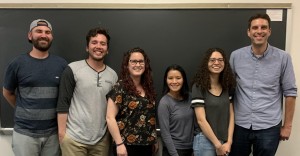What Biracial Face-Morphs Get Wrong, According to CSUN Student Researchers

Pictured from left to right: Eric Miller, Jonathan Benitez, Stephanie Dunn, professor Debbie Ma, Alana Parks and professor Justin Kantner. Photo courtesy of Jonathan Benitez.
To better understand the complex attitudes society might have toward the growing biracial population in the U.S., and how those compare to views toward individuals of other racial groups, researchers primarily use face-morph technology to generate artificial, digital representations of human faces that result from blending two faces typically assigned to a particular race.
Though this efficient and relatively inexpensive method is used widely in the field, questions arise as to whether the digitized likenesses of biracial individuals are reliably representative of their true selves.
California State University, Northridge graduate student Jonathan Benitez, who is set to complete his master’s degree in psychological science by next year, is taking a closer look at how face-morph technology can oversimplify the diverse identities of biracial individuals. As part of his research, Benitez examined how different identities are often pigeonholed into one category as a result of using this technology, and, in particular, how biracial people can be more accurately represented in face databases used for scientific study.
“As biracial populations continue to grow in the U.S. and abroad, it is increasingly important to research these individuals,” said Debbie Ma, associate professor in CSUN’s Department of Psychology.
A Pew Research Center report in 2017 found that one in seven babies born in the U.S. in 2015 were multi-ethnic, or belonging to two or more racial groups. This is a number that will continue to grow, as the US Census Bureau found that the percentage of interracial married-couple households grew from 7.4 to 10.2 percent between 2000 and 2012-2016.
Studies that explore these biracial populations often conclude that the perceptions between these racial categories tend to differ and can bear consequences in the everyday lives of members of certain groups.
For instance, a study could examine how biracial people might be treated differently compared to others when applying to jobs. “Imagine two of the exact same LinkedIn profiles, but one has a picture of biracial individual and one has a picture of a white individual,” Benitez said. If the biracial individual is perceived to be of the race of their minority parent, this study would likely conclude that the white individual has the advantage in getting employed.
After analyzing a variety of studies concerning the perception of race, his team found that participants in these studies identified the racial background of biracial individuals more accurately when they saw morphed faces as opposed to real faces. There are clear distinctions between perceptions of morphed and real biracial faces. “Morphs are not accurate representations of real biracial people,” he said.
Benitez is part of a research team made up of CSUN psychology students, including fellow graduate student Stephanie Dunn and undergraduates Eric Miller and Alana Parks.
The team conducted several psychological studies about how people classify biracial individuals through facial morphs. For example, a face conventionally classified as “White” and another classified as “Asian” were blended together using face-morph technology, and the resulting image was shown to participants in the studies.
Their preliminary findings showed that participants often assigned real biracial faces into a monoracial group — belonging to one racial group — and attempted to fit them under the “Latino” or “Middle Eastern” categories. However, when shown photos of morphed biracial faces, participants did not classify the faces as “Latino” or “Middle Eastern” as often.
The project raised questions about why this might be the case, and whether resulting images from face-morph technology actually mirror the appearance of real biracial individuals.
The idea of exploring biracial representation within the context of facial morphs stemmed from a collaboration between Benitez and CSUN associate professors of psychology Debbie Ma and Justin Kantner.
“We came up with the idea together,” Benitez said. “We saw a trend, and we wanted to find morphs whether morphs were actually representative of the biracial population.”
“Accurately acknowledging a person as biracial has consequences for an individual’s mental well-being. One study even showed that correctly categorizing a person as biracial by medical professionals can affect the accuracy of medical diagnoses and treatments a person receives,” Ma said.
The CSUN team’s research results led Benitez to question the value of using the facial morphs in the wider research community, he said. “Maybe we shouldn’t be using these morphs. Maybe we should be using real human faces,” he said.
Morphs are convenient, saving time and expense in putting together a database of faces that can represent humans, which is precisely why they are still being used. However, Benitez said, Ma has proven that creating databases with real faces is feasible.
Ma is one of the developers of Chicago Face Database, a database of high-resolution photographs of real people from a variety of ethnic backgrounds to be used for scientific research. Benitez and Ma said they hope to expand that database, and encourage the development of similar databases to include biracial individuals.

 experience
experience